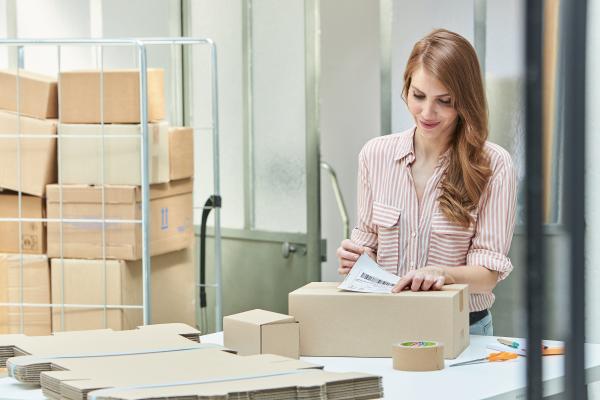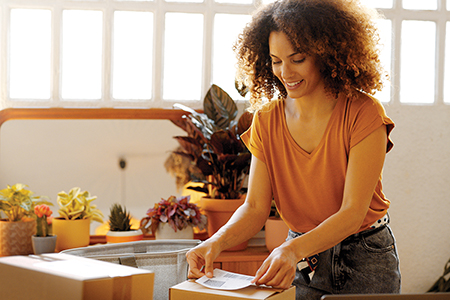The golden rules for a perfect parcel
A parcel in good condition on arrival generates a customer satisfaction score of 9.1/10. On the other hand, a parcel in poor condition due to the vacuum or the chosen packaging reduces this rating to 2.2*.
To achieve this, you need to pay attention to the type of packaging you choose, its size, the cushioning you use to keep the goods stable during transit, the way you close your parcel, etc.
Follow these golden rules for packaging your customers for the long term and your consignments will be a hit!

What makes a perfect parcel?
Thanks to all the explanations provided by Colissimo, discover the summary of best practices for packing and preparing your parcel by the Bayard-Théophiles, our family of e-buyers who have become experts, just like you soon will be.
5 golden rules for a well-packaged parcel
Like nature, your parcel hates a void.
At present, too much packaging is not adapted to the goods being sent, nor does it fit the goods themselves.
These packages contain a large amount of empty space that takes up unnecessary space in lorries, wasting raw materials and increasing pollution as a result! Not to mention the fact that they are not suitable for safe transport, i.e. for limiting the risks to your goods. Because when your parcel is empty, the risk of it reaching its recipient in poor condition increases by a factor of 3.

Choose packaging suited to the size of your product
Flexible pouches, cardboard, reusable packaging. Choose the best packaging format for your product, taking its size into account so that it fits your product as closely as possible. This way, you'll avoid any unnecessary empty space. What's more, if your parcel is small, it can be delivered directly to your recipient's letterbox.
Your packaging should also be regular and stable in shape (tubes aren't ideal because they roll... aren't they, Lola!).
Finally, to guarantee confidentiality and security, avoid affixing markings or other elements that could identify the contents, especially if they are valuable.

Wedging the product in the chosen packaging
A wedging solution "fixes" the product in its container so that it cannot move during transport. It also eliminates the residual vacuum, which could also be a source of damage to the packaging and your product. For example: a badly wedged lampshade could become a work of art on arrival.
There are many solutions on the market. Choose the cushioning solution that best suits your product, our environmental values or your budget: kraft paper, recycled cardboard, recycled and recyclable fibres, air cushions, but avoid using "chips" or "polystyrene" which can easily disintegrate and are extremely polluting.

Use an effective closing method
The best way to close a cardboard parcel is crosswise, using reinforced adhesive tape to avoid the risk of it opening during transport (forget office tape).
Take care not to cover the label, as this could obscure important information.
Similarly, don't use the label as a fastener, as it could tear.
You might be tempted to use additional fastening solutions such as string or strapping tape, but as soon as they become loose, they can become a real problem and delay delivery.

Apply a label to each parcel
The label is like the boarding pass for your parcel. All the information on it is invaluable for getting your customer's order to the right place on time.
It must :
- be at least 10x15cm in size
- be legible
- lie flat and uncreased
- be on one side of the parcel only
- not be under a plastic sleeve
- be unique (1 parcel = 1 label)
When it comes to legibility, our machines need to read barcodes and 3D codes perfectly.
To do this:
- Check your printer and its anchor
- Use non-porous paper
- Check that there are no white lines, scratches or lateral shifts
- Don't put it under a plastic sleeve or cellophane will create reflections that make it impossible to read

Respect the instructions
Remember to check the offer you have chosen, as your parcel must comply with minimum and maximum weights and dimensions.
Several parcels must not be bundled together using string, ties or strapping tape (right, Marion?).
Finally, you can send almost anything with Colissimo and La Poste, but not everything either. Some goods are dangerous and therefore prohibited. Others are prohibited in the countries to which you are sending them.

Letterbox delivery
Home delivery, directly to the recipient's letterbox, is very simple.
All you need is a parcel no larger than :
LxWxH = 24cm x 24cm x 32cm
These dimensions are those of the inside of a standard letterbox, including the small overhang there may be for the lock. After all that trouble-free travel, you wouldn't want it to be damaged at the very end.
Did you know ?
when your e-buyer receives their order directly in their letterbox, their satisfaction is at its highest, with a score of 9/10, because 95% of them find it effortless.
* Source: NPS and Colissimo customer satisfaction survey. T4.2022
Reminder of weights and dimensions by offer and delivery method

| HOME DELIVERY | RETURN | DELIVERY TO COLLECTION POINTS | ||
| With or without signature | In a post office | In a Pickup relay | In a Pickup locker | |
| We deliver all parcels with the following characteristics under your usual price conditions | ||||
| Up to 30kg inclusive** | Up to 20kg inclusive** | |||
| The maximum size of the largest side does not exceed 100cm and/or L+W+H≤150cm | The maximum size of the largest side does not exceed 60cm and/or L+W+H≤130cm | |||
| Focus on small parcels Remember to use the entire 1st 0-250gr weight band to lightly weight your consignment. These parcels must also have a minimum size. |
||||
| 16 cm (length) x 11 cm (width) x 1 cm (height) | 21 cm (length) x 16 cm (width) x 1 cm (height) | 16 cm (length) x 11 cm (width) x 1 cm (height) | ||
| We also deliver certain slightly larger parcels, at an additional cost*, as they require manual handling. | ||||
| All parcels with dimensions between 150 cm < L+W+H ≤ 200 cm**and/or with the longest side between 100cm < L ≤ 200 cm | N/C | |||
** Refer to the general rates for the current amount of the "non-mechanisable parcel" supplement.
** Varies according to country. Parcels destined for French Polynesia, New Caledonia and its dependencies, Wallis and Futuna and the French Southern and Antarctic Territories, the Postal Sectors and International, due to local distribution constraints, may not meet the standards defined in this section and are subject to more restrictive standards. A return of the parcel to the sender cannot be ruled out. To find out the details for each country, please consult the country sheets on the Colissimo Box(1) available on the website www.laposte.fr/colissimo-entreprise or ask your sales contact for details of the specific requirements for each country.
This content may be of interest to you:
Learn more >

Learn more >

Learn more >

